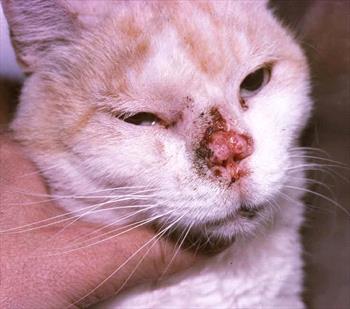Cat with nasal squamous cell carcinoma

This cat has a nasal squamous cell carcinoma. Photo used with permission from Dr. Barbara Stein.
Squamous cell carcinomas are tumors that are locally destructive and can spread aggressively in the area where they have arisen. That said, there are some circumstances where it is possible to either cure or achieve meaningful control of this tumor, and the nasal form is one of these situations.
The squamous cell carcinoma is associated with sun exposure, and this means that lesions on the white-furred areas of the feline face are at risk. The ear tips and nose are particularly vulnerable, as one might expect, as these areas are not well-protected by fur.
These tumors begin as a small scabby area that may not attract much attention as it can be mistaken for a minor abrasion. This minor abrasion, however, does not heal and continues to get larger.
Because squamous cell carcinoma does not spread distantly in the body until late in its course, this provides a window during which it can be successfully treated. Once it gets too big, that window has closed even if the tumor has not yet spread.
Surgical Treatment
If the tumor is not too big, surgical removal is curative. That said, squamous cell carcinoma can spread to surrounding tissues, so a wide margin of normal tissue must be removed in order to get the whole tumor. If the tumor has grown too large, there will not be enough tissue to get a good margin around it, and it will regrow, resuming its destructive course.
The surgery is ideally done with laser equipment to reduce bleeding; it is probably best to seek the skills of a surgery specialist or at least a veterinarian with a great deal of facial surgery experience. Your veterinarian may recommend a nerve block during surgery to help control pain after the procedure.
The leather of the nose is removed along with some of the surrounding haired skin. The nasal opening will heal cosmetically but will look a little unusual. Discuss with your veterinarian whether or not a referral to a specialist is in the best interest of you and your pet.
Surgical Recovery
Recovery can vary depending on the tumor size, location, and overall health of your cat. Your veterinary surgeon will give you post- operative instructions and can tell you what to monitor after taking your cat home, including what would be considered an emergency.
Preventing self-harm is crucial, and your cat may have to wear an e-collar or “cone” to prevent pawing at their face and harming the surgical site(s). Pain medications and antibiotics are commonly prescribed.
You may notice small drops of blood or nasal fluid coming from the nostrils right after bringing your cat home. They may also cough or have a “rougher” sounding voice from the tube placed during surgery which helps them to breathe while under anesthesia (endotracheal tube). Many cats don’t want to eat as much after surgery, and your veterinarian may recommend offering various foods to entice them, appetite stimulants, and surgery site cleaning under sedation (to allow them to smell their food).
Any excessive bleeding, difficulty breathing, changes in sleeping habits, or other situations after surgery should be discussed with your veterinarian.
Cryotherapy
Cryotherapy may be less invasive. This involves using a probe to freeze the tumor. Again, this can be curative if the tumor is small enough, but in freezing the tissue, the cells are damaged and can’t be analyzed by biopsy. The biopsy (lab analysis) of the tissue can confirm squamous cell carcinoma and enables the pathologist to tell if the excision was complete. This is valuable information that we would prefer not to forgo for obvious reasons.
Side effects of cryotherapy are generally mild and include swelling, redness, and pain. For the next 3-6 months your veterinarian will monitor your cat for signs of tumor regrowth. Cats with tumors that have grown into surrounding tissues also need to be checked for cancers in other areas. This may include X-rays of your cat’s chest and lymph node exams. For cases of nasal squamous cell carcinoma caused by sun exposure, the ears and eyelid margins also must be closely monitored along with the nose for regrowth of cancerous areas.
Cat after nose leather removal for nasal squamous cell carcinoma

Cat after nose leather removal for nasal squamous cell carcinoma Image courtesy MarVistaVet
Radiation Therapy
Radiotherapy is rapidly becoming the treatment of choice. Strontium plesiotherapy using strontium 90 involves applying a localized radiation source to the tumor directly for a brief period of time. (Imagine a wand with a radiation source on the end.) Radiation destroys tissue in a 3 mm diameter from the source, which allows for the destruction of small superficial tumors. As with surgery, if the tumor is too big, it cannot be cured.
Alternatively, external radiation beams can be aimed at the tumor under general anesthesia. In one study, 60 percent of irradiated cats had a complete response, and 33 percent had a partial response.
Radiation therapy obviously requires specialized equipment that is usually found only in specialty facilities. It is not available everywhere. A consultation with a veterinary oncologist will help determine if a given patient is a good candidate and what is involved in finding the nearest radiofacility.
Imiquimod 5% Creme
Imiquimod is an immunity-modifying topical crème that is palliative for tumors too large for curative removal or to treat the more superficial form of squamous cell carcinoma called Bowenoid carcinoma or squamous cell carcinoma in situ. Imiquimod is a relatively expensive product, and an upset stomach can result if the crème is licked (which it inevitably would be).
NSAIDs
You may not know the term "cyclooxygenase," but you are probably familiar with human anti-inflammatory cyclooxygenase inhibitors like aspirin, ibuprofen (Advil®), naproxen (Aleve®), and others. While these human anti-inflammatories are not safe for cats, there are some prescripton veterinary medications that are. This comes into play with nasal squamous cell carcinomas because there is potential for carcinomas to express enough cyclooxygenase that a feline-friendly non-steroidal anti-inflammatory pain reliever (such as piroxicam, meloxicam, or robenacoxib) may have anti-tumor effects. These medications are not completely without issues but may be helpful when other treatments are not an option, especially since they offer some pain relief.
Prognosis (Outlook)
Nasal squamous cell carcinomas usually do spread to tissues close by, but are slow to move to other areas in the body. Cats with superficial tumors (those that have not spread to deeper tissues in the nose or face) have better outlooks vs. large and deeply penetrating tumors.
Even though squamous cell carcinomas do not spread until relatively late in their course, they can still be extremely difficult to address. The nasal version is an exception to the poor prognosis rule as long as it is detected early and removed or treated with radiation promptly.
The potential for a full recovery depends on the size and location of the tumor, treatment procedures, and your cat’s overall health. Discuss your questions with your veterinarian. Also, talk about what you and your cat might experience. This will help you prepare for managing this condition as effectively as possible.